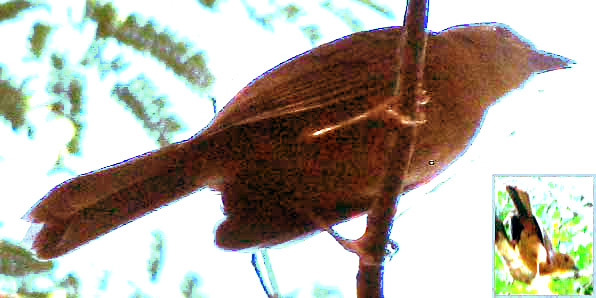Excerpts from Jim Conrad's
Naturalist Newsletter

from the January 3, 2010 Newsletter issued from Hacienda Chichen Resort beside Chichén Itzá Ruins, central Yucatán, MÉXICO; limestone bedrock, elevation ~39m (~128ft), ~N20.676°, ~W88.569°
SILHOUETTED BIRDS
The forest here is secondary, 25 years ago having been ranchland, cornfields, or very cut-over forest. Now forest is being left untouched around the ruins, gradually wildlife is returning, and in some places the forest already is tall and shadowy.
Often the most interesting bird species appearing in these shadowy areas just offer frustrating glimpses of themselves as they keep to heavy cover and dark shadows. That was the case the other day when three or four birds of a species I hadn't seen nearer Hacienda Chichen turned up in deep shadows, appearing as no more than silhouettes. I pointed my camera at them anyway, hoping for a lucky break. The best I could do is shown above.
Both the larger picture and the inset are grossly overexposed by PhotoShop in order to reveal features that otherwise would appear as pure, satiny blackness. Sometimes when the birds flitted through flecks of sunlight I could see that they were bright rusty, or reddish brown. The inset shows a yellowish bird but that's from the overexposure; it was really colored like the North's Brown Thrasher.
Note the tips of the tail feathers. Not many birds possess such sharp-pointed ones, and birds who do generally are those who forage a lot on vertical tree trunks, such as woodpeckers. But this was no woodpecker.
Best I can tell it's a Ruddy Woodcreeper, DENDROCINCLA HOMOCHROA, but I'm not betting my life on it. The beak doesn't look long enough, even though I've especially overexposed the head area so we can see how the beak extends well into the silhouette of the head, thus being longer than it looks. Ruddy Woodcreepers are not closely related to the North's Brown Creepers, though their tree-climbing behavior is very similar. They're also much larger than the 4-3/4-inch long (12 cm) Brown Creepers, being about 7-½ inches long (20 cm).
The three or four silhouette-birds were much involved with one another, churring constantly as they moved as a unit among shadows near the forest floor. The most notable part of their behavior, however, was how they quivered their wings like nestling robins begging worms from their parents. The bird in the picture appears to carry a straw so maybe here were several males trying to work a female into the right mood, as when several male gray squirrels follow a female all day until she's in the mood to mate with the dominant male.
If anyone out there has thoughts on all this I'd be glad to hear them.